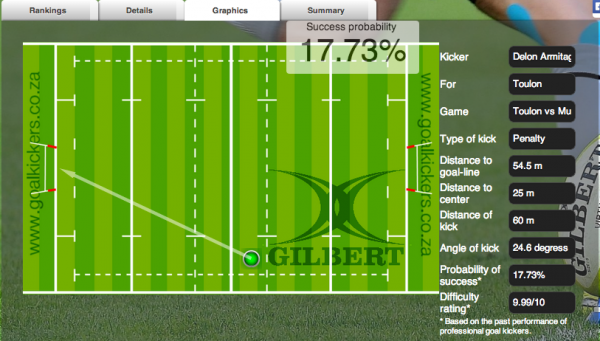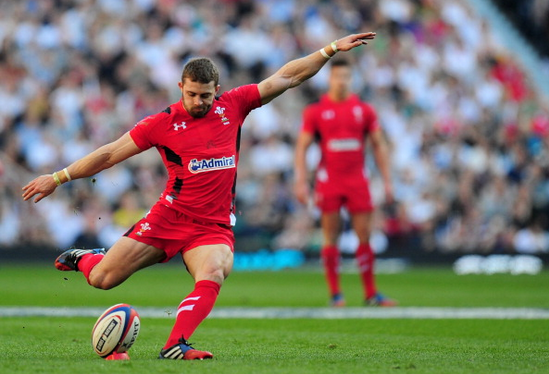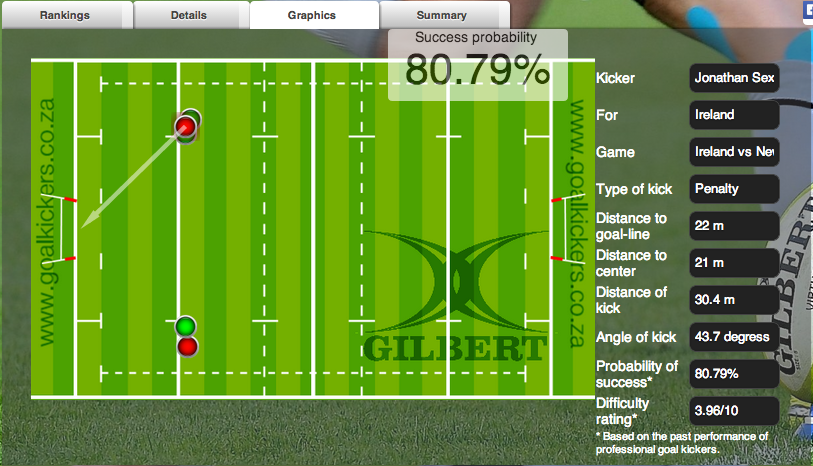How good was that kick, really? Two men decided to find out.
After the 2011 Rugby World Cup in New Zealand two men 7,592 miles apart put the wheels in motion to start ranking rugby place kickers in a different way. One was Ken Quarrie, Senior Scientist for New Zealand Rugby. The other? Jurie Nel, an actuary in Pretoria, South Africa with no union backing and no data feeds, just access to taped games and his computer. Two men on different sides of the world with similar plans, but with no idea of what the other was up to.
The Pace of Advancement
Research is a funny thing. Breakthroughs can be made completely independently at various times in various places. For example, the algorithms and mathematical principles behind Public Key Cryptography, the security mechanisms that enable so much of what we take for granted about secure digital communication (*waves cheerily at the NSA*), were developed in the late 1970s by a combination of Diffie, Hellman and Merkle (refined by Rivest, Shamir and Adleman) in the USA. The combined developments were a huge step forward in the field and those were the accepted names that went down in history.
Accepted, that is, until 1997 when it emerged through declassification that the same breakthrough had been made in GCHQ in England by James Ellis, Clifford Cocks and Malcolm Williamson. And they’d done it three years earlier than the Americans.
The work of the three had been Top Secret, shrouded from the world and commercially unexploitedi, so “history” had naturally recorded the Americans as having been first. Declassification of the GCHQ work has meant that history, if not being rewritten, has certainly had a new chapter to addii.
Kicking Percentage in Rugby – a Blunt Instrument
Rugby is by its nature a game of fluidity and chaos interspersed with moments of structure. It is what is known as a “field invasion sport”, something that is altogether harder to pick apart than a sport containing a series of discrete events like baseball. However, place kicking is one area of rugby that can be relatively easily isolated and analysed – one ball, one player, one set of posts – yet the only stat to which most fans have had access is a simple kicking percentageiii.
Although blunt, kicking percentage is useful in that it’s better than nothing. But even if you’ve never stood over a touchline conversion on a boggy pitch while squinting your eyes into a howling wind you will know that all kicks are not the same. There can be wind and rain. Some stadiums are fully enclosed, some even have a roof, others remain exposed to Mother Nature and her whims. Is it a kick to take the lead? Or even to win the game? And then there’s the simple stuff, like how tight the angle is. Or whether the posts just seem small or are actually very far away.
Both Quarrie and Nel felt that it was time to squeeze more useful information from kicking in rugby. Independently they each developed models, and rankings, and over the last few months I talked to them both.
Jurie Nel – the Curious Actuary with a Rugby Question
Nel, 36, grew up in Johannesburg, South Africa, and now lives in Pretoria with his wife and two young kids, Anke and Liam. He is an actuary by profession and looks after product development at Assupol, a life insurance company based in Pretoria.
How did he get the idea for a new way of ranking goalkickers?
“I still remember the day”, Nel told me. “Before World Cup 2011 I was watching a game where Patrick Lambie had a shot in front of the goal. The commentator mentioned that Lambie’s kick success average was really good that season but it struck me that many of his kicks had been very easy, just like that one.”
That had been from memory, of course, and perception can play tricks. Big moments in big games are remembered, others forgotten. So to perform a study on this seemed the natural thing to do for Nel, who said he had studied actuarial science at the University of Johannesburg and had done some projects on cricket analysis while there.
Nel’s study turned into a paper* published in the South African Journal for Research in Sport, Physical Education and Recreation (2013 Volume 35, No. 1). It had two stated goals; to estimate the success probability of a particular place kick attempts and to derive a ranking mechanism for rugby goalkickers. Nel used the performances from the 2011 Rugby World Cup to illustrate the rankings – “I got data from the 2011 Rugby World Cup – Jonny Wilkinson had had a very poor success rate but he’d had very difficult kicks, the second highest difficulty in the competition.”
*Link to the paper abstract (PDF): http://academic.sun.ac.za/sajrsper/35.1/Nel.pdf
Nel’s model is complex. He told me that he originally plugged in as many variables as possible – angle, altitudeiv, the side of the field, what foot the kicker kicks with, pressure in terms of the score difference, and more. Essentially Nel’s logistic regression model tries to estimate which are the most important variables.
The biggest impacts? “The obvious ones – distance and angle. Altitude doesn’t come into it as much as there’s an element of self selection – you don’t see a lot of 55m misses at sea level because in general guys won’t attempt from there”.
The Goalkickers Website
Nel’s model is now the basis for www.goalkickers.co.za, a website that Nel launched in 2013 along with software developer Francois Theron.
The graphical nature of Theron’s site design for www.goalkickers.co.za makes things easy to grasp. Rugby fans can use various drop down menus to choose the kicking data they want to see, whether that is all kicks from a particular competition or just for one kicker in one game. All kick attempts are visually represented on a pitch; green dot for success, red for failure and in a margin to the right hand side of the graphic some brief notes about the difficulty of each attempt.

The Top 10 Goalkickers in Test Rugby, 2013, from www.goalkickers.co.za including Jurie Nel’s “Points Gained”
I’ve written before about the Strokes Gained statistic developed by Mark Broadie for the golfing world; Nel’s version for rugby is “Points Gained”, a calculation of the number of extra (or fewer) points their kicks have earned their team over the average kicker. And in 2013 Wales’ Leigh Halfpenny was top of the Points Gained heap.
Manual Effort
Nel says it takes him about 20 minutes to code a match, based on there being around 10-12 place kick attempts per game. He’s coded more than 5,000 kicks, with the site holding all the kicks that he’s coded since 2012 and uploaded using Theron’s interface.
The coding process is currently done manually from recorded match video and, as Nel is based in South Africa, most of the kicking stats on the website are naturally Southern Hemisphere based – Super Rugby and the Rugby Championship. There is good news for Northern Hemisphere fans, however, as Nel has coded all kicks from the 2014 Six Nations as well as the semi-finals and final of the 2014 Heineken Cup.
Munster and Toulon fans will remember this monstrous effort from Delon Armitage in the 2014 Heineken Cup semi final in Nice Marseilles (skip forward to 15 seconds or so)…
In Nel’s world, that kick had a 17.73% probability of being made.

Delon Armitage’s monster 60m penalty vs Munster in the 2014 Heineken Cup semi-final (screengrab from www.goalkickers.co.za)
Nel also coded the 2013 Autumn Internationals including, yes, Jonathan Sexton’s crucial miss against New Zealand.
Who knows the pressure Sexton was under as he stood for an age over the ball, but according to Nel’s model it was a kick that 4 out of 5 times goes over the bar.
Gilbert Endorsement. And Data?
Even without the challenges of getting video for each game the manual aspect of the work is an obvious limitation for keeping the site going, let alone expanding it. The next step will be to get a data provider involved. “Without data sources, it’s a hobby that after time might get boring. I might turn to something else!”, Nel told me.
The recent agreement of Gilbert Rugby to endorse the venture was therefore most welcome. And as a high profile manufacturer of rugby balls, Gilbert hooking up with a goalkicking website makes intuitive sense.
“It was probably a year ago that we made a list of who might be interested in the site”, said Nel. “Gilbert, as a ball manufacturer, were on it. At this stage there is no monetary support from Gilbert – they say they like the idea, will put endorsement behind it and will move to link up with data companies”.
For Nel and Theron, one short term goal is to get their goalkicking rankings used as part of the coverage of Rugby World Cup 2015. Seeing such things on screen and in print would certainly have some appeal in this analytics-driven parish and with a data provider behind it much of the manual work could be removed, which could open up many possibilities.
Next: to New Zealand, and NZ Rugby Senior Scientist Ken Quarrie
Update 13/06/2014: Screenshots from www.goalkickers.co.za replaced with more accurate versions. The originals were at a different zoom level that distorted the kick visualisation slightly. Jurie’s looking into why that is the case.



Comments
One Response to “How good was that kick, really? Two men decided to find out.”Trackbacks
Check out what others are saying...[…] The second in a series on place kicking analysis in rugby union. The first featured the work of Jurie Nel. […]